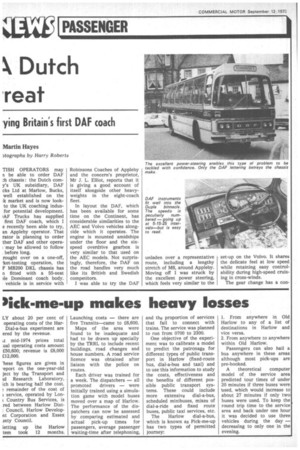lick-me-up makes heavy losses
Page 28

If you've noticed an error in this article please click here to report it so we can fix it.
LY about 20 per cent of operating costs of the HarDial-a-bus experiment are ered by the revenue.
a mid-1974 prices total ual operating costs amount £50,600; revenue is £8,000 E12,000.
'hese figures are given in • eport on the one-year-old ject by the Transport and id Research Laboratory, ich is bearing half the cost.
remainder of the cost of ; service, operated by Lon i Country Bus Services, is red between Harlow Dist. Council, Harlow Developnt Corporation and Essex anty Council.
ietting up the Harlow tern took 12 months. Launching costs — there are five Transits—came to £6,600.
Maps of the area were found to be inadequate and had to be drawn up specially by the TRRL to include recent buildings, road changes and house numbers. A road service licence was obtained after liaison with the police on routes.
Each driver was trained for a week. The dispatchers — all promoted drivers — were initially trained using a simulation game with model buses moved over a map of Harlow. The performance of the dispatchers can now be assessed by comparing estimated and actual pick-up times for passengers, average passenger waiting-time after telephoning, and the proportion of services that fail to connect with trains. The service was planned to run from 0700 to 2300.
One objective of the experiment was to calibrate a model to predict the patronage for different types of public transport in Harlow (fixed-route bus, dial-a-bus and taxi) and to use this information to study the costs, effectiveness and the benefits of different possible public transport systems. These could include more extensive dial-a-bus, scheduled minibuses, mixes of dial-a-ride and fixed route buses, public taxi services, etc.
The Harlow dial-a-bus, which is known as Pick-me-up has two types of permitted journey: 1. From anywhere in Old Harlow to any of a list of destinations in Harlow and vice versa.
2. From anywhere to anywhere within Old Harlow.
Passengers can also hall a bus anywhere in these areas although most pick-ups are pre-booked,.
A theoretical computer model of the service area predicted tour times of under 20 minutes if three buses were Used, which would increase to about 27 minutes if only two buses were used. To keep the round trip time to the service area and back under one hour it was decided to use three vehicles during the day — decreasing to only one in the evening.
















































































































